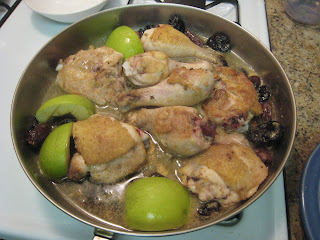***
Thursday was going to be dessert day. I went a little overboard on purchasing ingredients, and somehow convinced myself that I was going to have time to make three different recipes and still have time to get my reading done for class on Friday. This was incorrect. I did, however, find the time to make Sallet of Lemmons and Foolproof Gooseberry "Foole".
We begin with the lemons. The Sallet of Lemmons is included in the Sallet chapter, but its role as a food item is a bit nebulous. We're talking combination aperitif, digestif, fish accompaniment... Most importantly, it was very easy to make, and that made it a good candidate for a multi-recipe night.
The recipe itself suggests using a sharp knife to peel the lemons, but that is the sort of manual task at which I am likely to fail and/or sever fingers. I had also just purchased a vegetable peeler, so was leaning in that direction. I decided to put the two methods to the test.
Vae victis! The offending paring knife was sold into gladiatorial slavery shortly after this picture was taken. The peeler was much better at providing me with something resembling uniform strips of lemon peel.
The peel is julienned, and then I rediscover my camera's macro setting.
This is followed by triple-blanching the strips of lemon peel. Boil, drain, rinse; boil, drain, rinse; boil, drain, rinse.
The lemon peels join the now-sliced lemons in a container...
...so that they can be tossed with sugar.
The mixture sits for at least an hour, during which time I realized that despite purchasing the ingredients for three different dishes, I hadn't actually picked up anything for dinner. A frozen chicken pot pie (not pictured) goes into the oven. At the end of the hour, I have Sallet of Lemmons (no pot pie is involved). It's hard to see the sugar on the lemons in the picture, but rest assured that it's there.
And here we have the Sallet hanging out with some crusty bread and olives, since Shakespeare's Kitchen suggests that this was the way it was commonly done back in the day.
I experiment with the dish for a bit - I eat lemon using my hands, just the fork, knife and fork, sallet on bread... Here's the problem: at the end of the day, what we have is sliced lemons with sugar. Do you have a lemon in your kitchen? Go to it. Cut it open. Try to eat it like an orange. Try again after sprinkling a little bit of sugar on it. Eat half of the lemon. Find yourself wondering, "Why? Why exactly did I do that? Why do I hate myself so much?" These are good questions to have. If you are already the sort of person to eat a lemon, with or without sugar, then this recipe is for you. There was some talk of using the lemons in lemon-drops, but there is apparently no vodka in my apartment.
On to the Foolproof Gooseberry "Foole". Gooseberries, for those of you who don't know, are not native to the Washington, DC area, nor to my local grocery stores. Gooseberry bushes also produce their fruit in June and July, which is the opposite of January. Shakespeare's Kitchen suggests that any kind of berry will work for the Fool, but I decided to get fancy and check Cook's Thesaurus to see if there were specific substitutions I should be trying to make. The entry for gooseberry suggested rhubarb, red currants, and (oddly enough) kiwis, and specified that the rhubarb and kiwi were both excellent choices for fools. I was a little annoyed to discover that everyone but me seemed to already know what a fool was, but I eventually got on with my life. I settled on kiwis, and took four of them back for foolery. Also, for more macro photography.
Here you can see three of the four kiwis skinned and ready for cooking. The last one is spared for the moment, since it will become fancy garnish.
Into the boiling water the kiwis go! They start losing color really quickly, which I wasn't expecting. Not for any particular reason, I've just never had something I cook go white from boiling. I guess I don't do enough blanching.
After they cook for a few minutes, the kiwis are drained, and mashed with a fork, and then mixed with sugar and a bit of
Once that's taken care of, we need whipped cream. I started with the noble goal of whipping the cream myself with a fork. Then I got bored and switched to a whisk. Then my arm started to hurt and the cream wasn't moving past the thick liquid stage, so I closed the container and shook it for maybe five seconds and then my whipped cream was magically done.
Sugared kiwi mixture goes into the little dishes.
Whipped cream on top, kiwi slices for garnish, and completely forgetting to sprinkle it with turbinado or brown sugar as the recipe actually calls for. Et voilà!
The Foolproof
The only line in Shakespeare involving a lemon is "A lemon."






















































